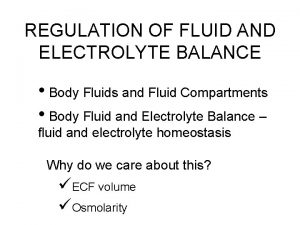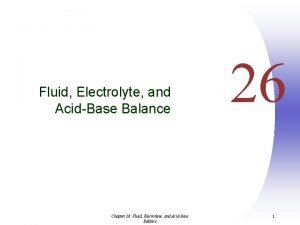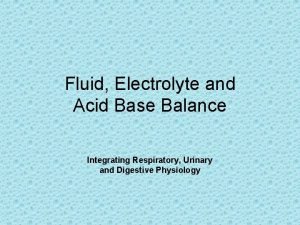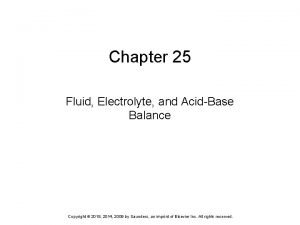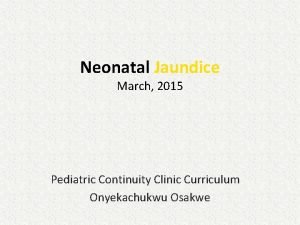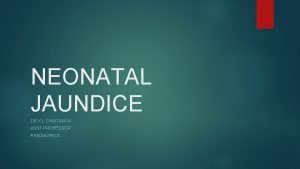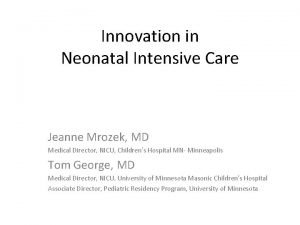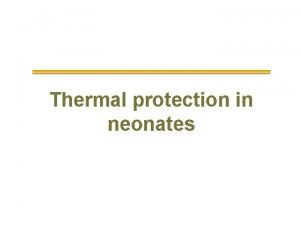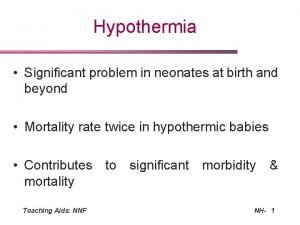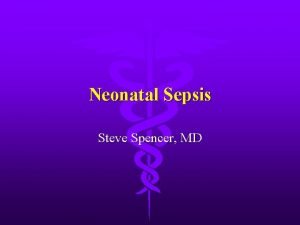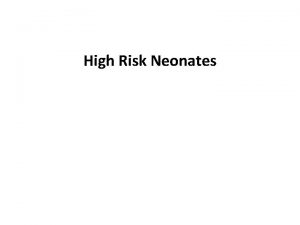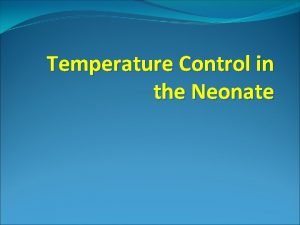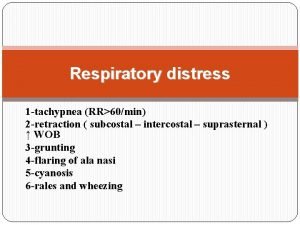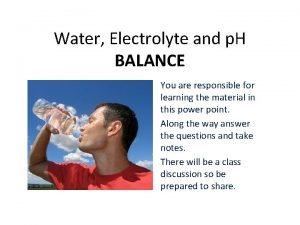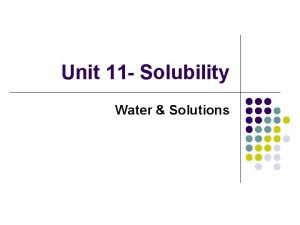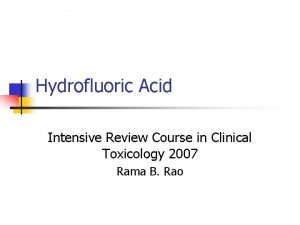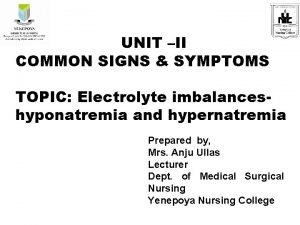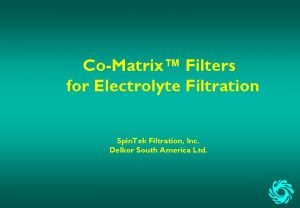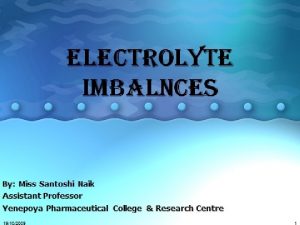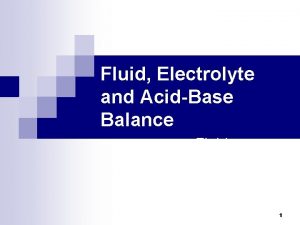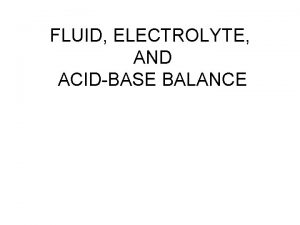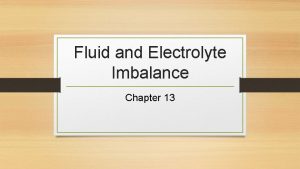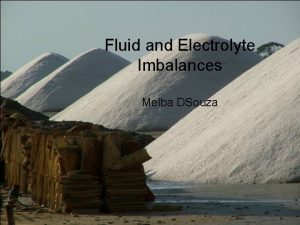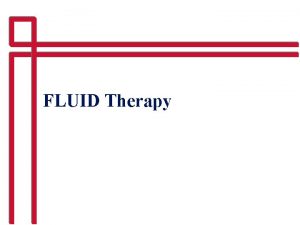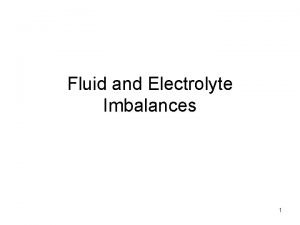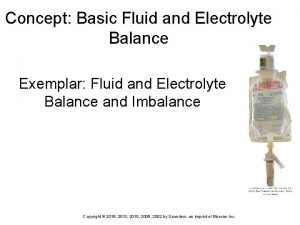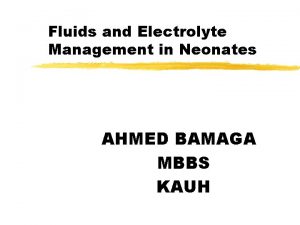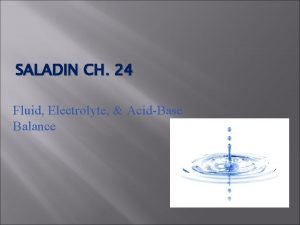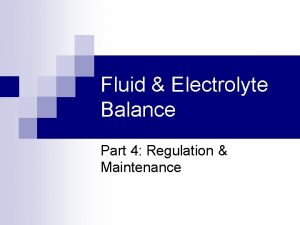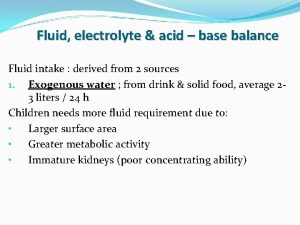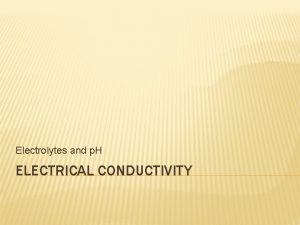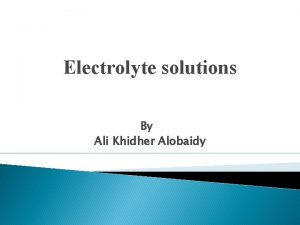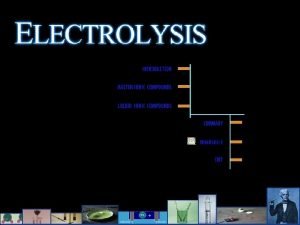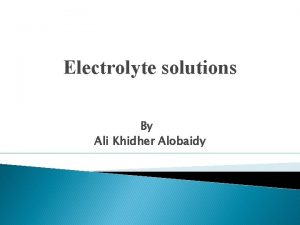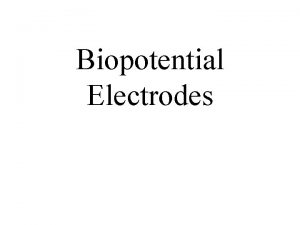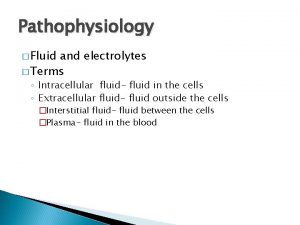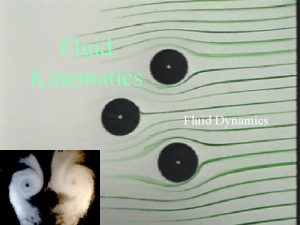Fluid and Electrolyte in Neonates Why is this









































- Slides: 41

Fluid and Electrolyte in Neonates ? Why is this Important Neonatal physiology is different Fluid management is not uniform Serious morbidity can result from wrong fluids Organ systems are ill equipped to handle blunders ! Fluids must be “ Tailor made “

How is it Different ? TBW ECF ICF Adult 60% 20% 40 % Term 75% 40% 35% 60% 30% Preterm 80 -90%

Fluid compartments TBW = ECF + ICF E C F = Intravascular + Interstitial

Organs Regulating Fluid balances 1. Cardio- Vascular system Immature Myocardium – ↓ contractile elements Unable to respond to volume overload 2. Poor capillary integrity Intravascular volume depletion

Renal System Only 25% functional ability at birth Poor diluting and concentrating ability ↑ Intra vascular volume → edema Tubular immaturity - polyuria

Renal system – contd Preterm <30 wks - Natriuresis with hyponatremia Concentrating ability improves from 30 wks onwards

Skin in a preterm baby


Insensible Water Loss 70% I W L = Skin 30% I W L = Resp Tract

Insensible Water Loss < 1000 gms - 100 ml/kg/day 1000 -1500 gms – 60 ml/kg/day >1500 gms -- 20 ml/kg/day

Premie with Cling wrap




Sensible Water Loss Urine output preterm – 2 -3 ml/kg/hr Osmolality -60 -600 m. Osm/L Stool output preterm - 7 ml/kg/day Term - 10 ml/kg/day

Factors affecting I W L ↑ IWL Warmer Phototherapy ↑ RR Skin injury-tapes Low Humidity ↓ IWL Incubator Heat shield Cling Wrap Caps socks

Cling Wrap ↓ I W L by 50 -70% PREVENTION of I W L should be the goal

Fluid Calculation Term Baby - 60 -70 ml / kg ↓ How ? ? Solute load - 15 m. Osm/kg/day in urine Urine output – 50 ml/kg/day + I W L - 20 ml / kg/ day Total fluid - 60 -70 ml/kg/day 1 st 24 hrs - 10% Dextrose - No lytes

Fluid calculation – Preterm Urine output – 50 -60 ml /day + IWL > 30 -40 ml / kg /day Total = 80 -100 ml/kg/day

Monitoring Fluid status 1. Body weight - Term baby - loss of 1 -3% daily Cumalative loss – 5 -10% in 1 st week Preterm babies – 2 -3% daily Cumalative loss - 15% by 1 week NOTE – Body Weight reflects TBW, not intra vascular fluid Puffy baby may be fluid depleted ! !

Monitoring Fluid Status 2. Clinical signs of Dehydration - sunken AF, poor turgor etc MOST UNRELIABLE 3. Serum Sodium – 135 - 145 m. Eq /L Serum Osmolality

Monitoring Fluid status 4. Urine Output -1 -3 ml /kg /day Urine specific gravity - 1005 -1010 Urine Osmolality - 100 -400 m. Osm / L 5. A B G - Metabolic acidosis 6. Serum Creatinine – must ↓ in first week Failure to decline ? Is worrying

Guidelines - Fluids ↑ ↑ Fluids Wt loss > 3% Na > 145 Urine sp grav>1020 Output <1 ml/kg/hr ↓↓ Fluids No wt loss Na < 130 Sp grav <1005 U O >3 ml kg/hr

Daily increment in fluids 1. With feeds – Solute load ↑ in urine 2. ↑ water for growth and fecal losses ↓ ---so Total fluids ↑ by 15 -20 ml/kg/day Add Lytes after 48 hrs - Na, K G I R - 4 -6 mg / kg /min

Fluids at end of a week Skin of a preterm baby - Matures - I W L ↓ in preterm babies Total fluids – 150 -160 ml/kg/day Na reqr 2 -3 m. Eq /kg/day in term 4 -5 m. Eq/kg/day in preterm ( till 33 -34 wks ) K reqr - 2 m. Eq/kg/day in all babies

Lytes -- contd Calcium - 1 st day - < 1500 gms 35 -70 mg/kg/day elemental calcium 4 -8 ml /kg /day - 10 % Ca gluconate

Sodium Problems Hyponatr + wt loss -- ↑ sodium Hyponatr + wt gain -- ↓ fluid Hypernatr + wt loss -- ↑ fluid Hypernatr + wt gain -- ↓ fluid ↓ Sodium

Hyponatremia –Treatment ( Desired – Actual ) × 0. 8 × body wt ? ? How rapid – SYMPTOMATIC CASES correct till 125 mmo. L – 1 st 6 hrs rest over 24 hrs ASYMPTOMATIC - ½ CORRECTION – 12 HRS ¼ - BY 18 HRS ¼ - BY 24 HRS

HYPERNATREMIA ? ? CAUSES 1. Negative water balance 2. Sod bicarb, conc formula Symptoms - Hyperreflexia, seizures, coma ? Permanent CNS sequelae CORRECTION - SLOW PROCESS ↓ about 10 m. Eq every 12 hrs

HYPERKALEMIA k + = > 6 m. Eq/L brady, arrhythmia, ventr. Fibrillation Early EKG –peaked t wave, wide QRS ? ? Causes Non-oliguric hyperkalemia(ELBW ) Sepsis, ARF, acidosis, CAH Haemolysed sample –beware ! !

Hyperkalemia

Hypokalemia

Treatment -Hyperkalemia Stop K+ containing fluids I. V. Calcium gluconate 2 ml/kg Insulin infusion-0. 1 U/kg/hr with Dextrose K+ Exchange resins – (watch Sodium) Exchange transfusion Peritoneal Dialysis

Special Circumstances R D S - Adequate fluids Not excessive B P D - Restrict fluids ↑ Calories P D A - Restrict fluids ? Medications

Special situations –contd Asphyxia - Restrict initially ? ATN ? SIADH N E C -- More fluids A R F - 400 ml / m 2 + Urine output


References Medscape Neo rev Up. To Date AIIMS protocol



Thank you !

 Fluid and electrolyte balance ppt
Fluid and electrolyte balance ppt Homeostatic responses to respiratory acidosis
Homeostatic responses to respiratory acidosis Water distribution in the body
Water distribution in the body Chapter 26 fluid electrolyte and acid-base balance
Chapter 26 fluid electrolyte and acid-base balance Chapter 25 fluid electrolyte and acid-base balance
Chapter 25 fluid electrolyte and acid-base balance Normal electrolytes values
Normal electrolytes values Why why why why
Why why why why Bhutani nomogram
Bhutani nomogram Icterus grading
Icterus grading Facilitated tucking neonates
Facilitated tucking neonates Mechanisms of heat loss in newborn
Mechanisms of heat loss in newborn Warm chain
Warm chain Normal cbc in neonates
Normal cbc in neonates Definition of high risk neonate
Definition of high risk neonate Warm chain
Warm chain Tachypnea causes
Tachypnea causes Transcellular fluid
Transcellular fluid Extracellular fluid and interstitial fluid
Extracellular fluid and interstitial fluid Water electrolyte imbalance
Water electrolyte imbalance Weak electrolyte examples
Weak electrolyte examples Hf electrolyte
Hf electrolyte Refeeding syndrome electrolyte abnormalities
Refeeding syndrome electrolyte abnormalities Signs of hyperkalemia
Signs of hyperkalemia Larox dm dual media electrolyte filter
Larox dm dual media electrolyte filter Degree of dissociation of electrolyte depends on
Degree of dissociation of electrolyte depends on What is an electrolyte
What is an electrolyte Major physiological anions
Major physiological anions Viscoseal
Viscoseal P1-p2
P1-p2 Fluid statics deals with
Fluid statics deals with Solute definition
Solute definition Interstitial vs intracellular
Interstitial vs intracellular Fluid mechanics chapter
Fluid mechanics chapter Ascitic fluid neutrophil count
Ascitic fluid neutrophil count Don't ask why why why
Don't ask why why why Why-why analysis
Why-why analysis Wh tongue twister
Wh tongue twister Does this table represent a function why or why not
Does this table represent a function why or why not What does a table represent
What does a table represent Why or why not
Why or why not Contoh root cause
Contoh root cause Difference between crystalized and fluid intelligence
Difference between crystalized and fluid intelligence


